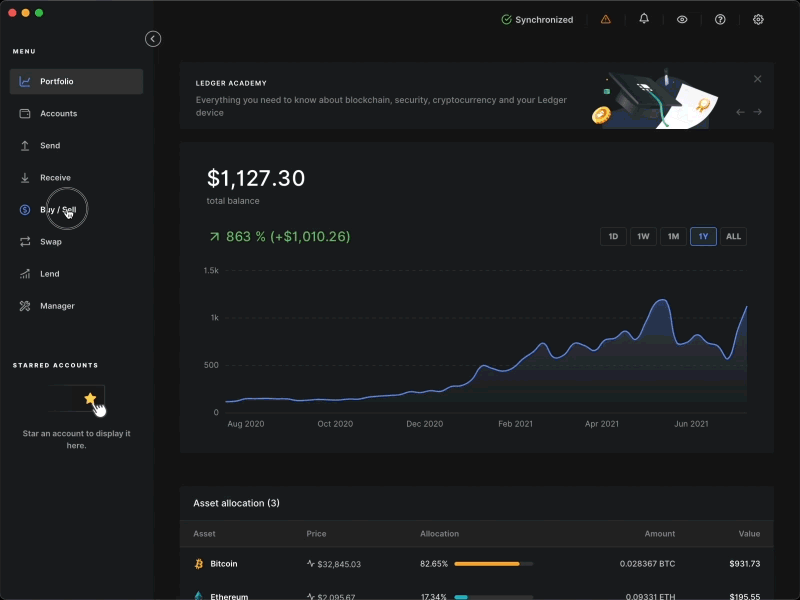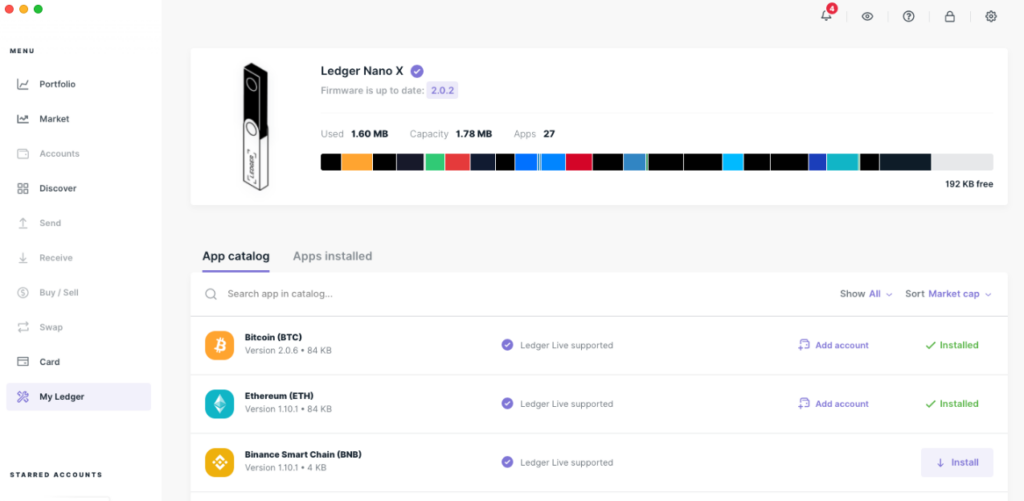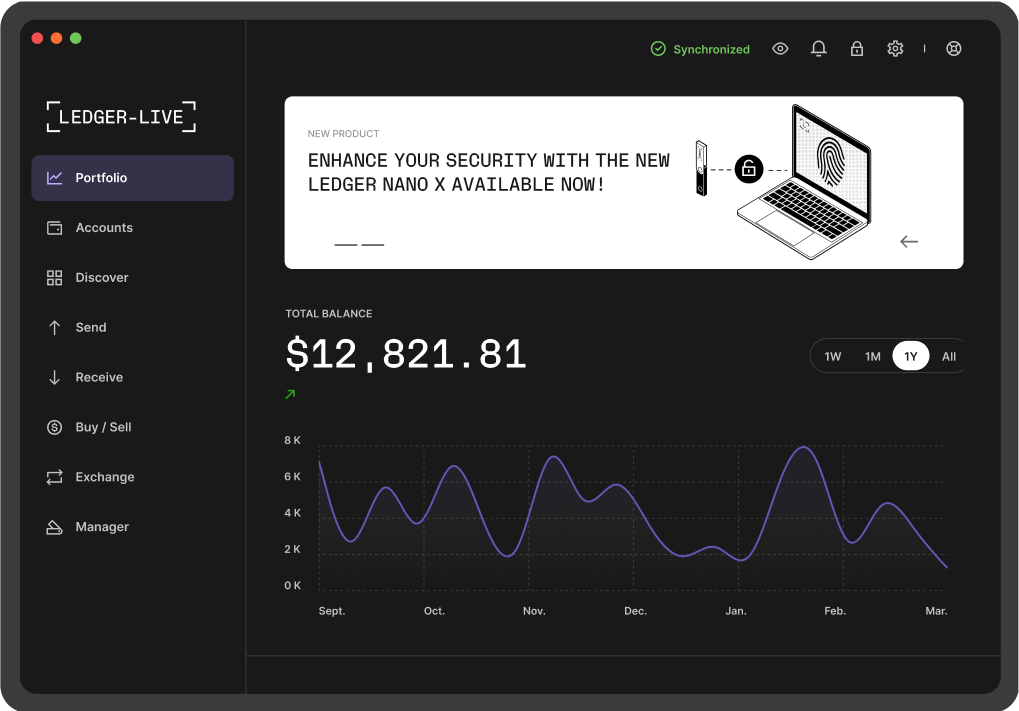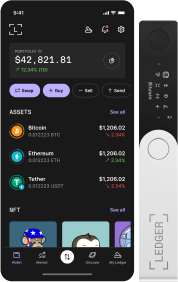Ledger Live – Download and Get Started with your Ledger
- Beginner Resources
- How To Use Ledger Live
The Collective Shift Guide
Ledger Live is an application that you can download on your desktop or mobile phone. The Ledger Live software lets you safely interface with your Ledger hardware wallet device.
Think of Ledger Live as a bridge that connects you and your Ledger!
In this resource, you’ll get an understanding of the Ledger Live software app. If you skipped a step
👇
Cryptocurrency Wallets
What Is Ledger Live?
Ledger Live is a desktop and mobile app. The Ledger Live app is made by the same company that makes the Ledger crypto hardware wallet. By using Ledger Live, you can send cryptocurrencies such as bitcoin to and from your Ledger hardware wallet.

What Is The Ledger Live App For?
Ledger Live is a secure and user-friendly interface for accessing and managing your cryptocurrency via Ledger hardware wallets. It simplifies balance checks, transfers and even allows staking for certain cryptocurrencies.
How to set up apps
To send or receive any crypto, the first thing you need to do on your new Ledger is install the apps for the cryptocurrencies you want to store.
Think of it like an app on your phone. You just have to find it and install it!
If you want to store or transfer Bitcoin, download the Bitcoin app.
If you want to store or transfer Etheruem (or any tokens living on Etheruem) install the Eth app.
These two are your best starting apps!

Staking cryptocurrency with Ledger Live
Staking cryptocurrency is similar to—but not exactly the same as—earning interest from your bank on your savings account. For letting the bank hold your money, they pay you some interest on a regular basis.
With staking, you earn rewards in return for locking up—or staking—your cryptocurrency in special contracts that help secure the blockchain network to which that cryptocurrency is native.
The cryptocurrencies that you can stake from your Ledger Live include, but are not limited to Tezos (XTZ), Solana (SOL), Ethereum (ETH) and much more. If you own some XTZ tokens, you can stake them through the Ledger Live app to help secure the Tezos blockchain. Similarly, if you own some TRX, you can stake them to help secure the Tron blockchain.
In both cases, you will earn XTZ and TRX as compensation for choosing to participate in staking.
When you are staking with Ledger Live, it is important to note that your private keys remain in your wallet at all times. This means that you remain in control of your cryptocurrency at all times.
Universal 2nd Factor authentication
Since Ledger hardware wallets are secure ways to store private keys, the Ledger Live software can be configured to function as a multi-factor authentication (MFA) device.
When you have MFA enabled, it becomes harder for people to pretend to be you.
People choose to enable MFA for accounts that are very important. Examples of accounts that will typically have MFA: email, social media, mobile phone, bank, and crypto exchange.
To enable MFA on your Ledger crypto hardware wallets, find the FIDO U2F app in the Manager section of your Ledger Live app. Click the ‘Install’ button next to FIDO U2F.
Once installed, open FIDO U2F on the dashboard of your Ledger device. Here, you can go to the security settings of web services—such as Facebook, Google, and Dropbox—and register your Ledger device.
What is 2FA?
Ledger Live Download & Install
The Ledger Live software is available on desktops across Windows, Mac, and Linux. It is also available for mobile on Apple iOS and Android OS.
Ledger Live desktop
Installing Ledger Live is extremely simple. You can do so by visiting the official Ledger website and navigating to the download Ledger Live page.
There are three options once the Ledger Live software is up and running.
- Set up a new device. Select if you have just purchased a new ledger hardware wallet)
- Restore the device from a recovery phrase. Select if you are restoring from an existing hardware wallet that you previously configured.
- Skip device setup. Select if you already have a Ledger wallet set up and configured.
Once you have unlocked your existing or newly configured Ledger hardware wallet, you can start using Ledger Live. Sending and receiving is relatively straightforward. (If you are requiring further assistance, visit the support section of the official Ledger website.


Ledger Live mobile
To set up the app on your mobile, simply visit Apple’s App Store or Google’s Play Store. From there, you can install the app by following the prompts. After installation and opening the app for the first time, you’ll see the following options:
- Import your accounts from your Ledger Live desktop
- Initialise as a new device
- Restore from a recovery phrase
- Use an initialised device
You can connect your hardware wallet to your phone directly using an OTG cable. Alternatively, if you have a Ledger Nano X—which has Bluetooth capabilities—you will be able to pair the device wirelessly over Bluetooth.
Ledger Live is a companion application for Ledger hardware wallets, providing a secure interface for managing your cryptocurrency assets. It allows you to buy, sell, swap, stake, and manage your crypto and NFTs, all while keeping your private keys securely stored on your Ledger device.
Here’s a guide to using Ledger Live:
1. Installation and Setup:
- Download and Install:Download the Ledger Live application from the official Ledger website for your operating system (Windows, macOS, Linux, or mobile).
- Connect Your Device:Connect your Ledger hardware wallet (like Nano S or Nano X) to your computer or mobile device using the USB cable.
- Initialize/Restore:
- If it’s your first time using the device, choose “Set up a new device” and follow the instructions to generate a new recovery phrase.
- If you have an existing recovery phrase, choose “Restore your recovery phrase” to regain access to your accounts.
- Set PIN and Security:Set a PIN code for your device and keep your recovery phrase (24 words) in a safe and secure place.
2. Managing Your Accounts:
- Add Accounts:Open Ledger Live and navigate to the “Accounts” section. Add accounts for the cryptocurrencies you own by selecting the corresponding app on your Ledger device.
- Receive Funds:To receive cryptocurrency, go to the “Receive” section in Ledger Live, select the desired cryptocurrency, and follow the instructions to get your wallet address.
- Send Funds:To send cryptocurrency, go to the “Send” section, enter the recipient’s address, the amount, and transaction fees, then confirm the transaction on your Ledger device.
- View Balances and Transactions:You can view your account balances and transaction history within the Ledger Live app.
3. Interacting with Apps and Services:
- Install Apps:Ledger Live allows you to install apps for various cryptocurrencies and services (like Bitcoin, Ethereum, etc.) on your Ledger device.
- Use dApps:The “Discover” section in Ledger Live allows you to access various decentralized applications (dApps), such as those for buying, selling, swapping, and staking crypto, as well as managing NFTs.
- Buy and Sell Crypto:Ledger Live integrates with various services, enabling you to buy and sell cryptocurrencies directly within the app.
- Stake Crypto:You can stake supported cryptocurrencies through Ledger Live to earn rewards for helping to secure the blockchain network.
- Swap Crypto:Ledger Live allows you to swap one cryptocurrency for another within the app.
4. Additional Features:
- NFT Management: Ledger Live allows you to manage your NFTs (Non-Fungible Tokens) securely.
- Market Data: Ledger Live provides market data for various cryptocurrencies.
- Clear Signing: Transactions within the Ledger Live ecosystem are secured by Ledger’s Clear Signing initiative, which allows you to verify transactions on your Ledger device’s secure screen.
Important Notes:
- Always download Ledger Live from the official website to avoid scams.
- Keep your recovery phrase safe and secure, as it’s crucial for restoring your accounts if your device is lost or damaged.
- Be cautious of phishing attempts and verify transaction details on your Ledger device before confirming.
- Refer to the official Ledger documentation for detailed instructions and troubleshooting.